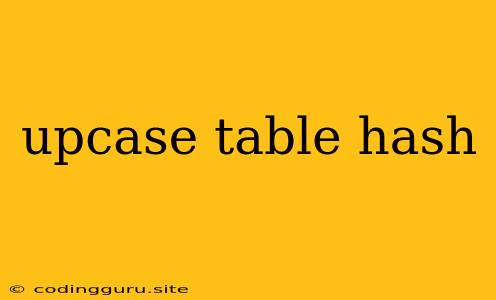Understanding Upcase and Hash Tables: A Comprehensive Guide
In the world of software development, hash tables are a cornerstone data structure used to efficiently store and retrieve data. They are often implemented in various programming languages, including Ruby. Understanding how they work and how to utilize them effectively is crucial for optimizing your applications.
Upcase is a popular online learning platform that offers comprehensive Ruby and JavaScript courses. One key concept taught in their curriculum is the use of hash tables within Ruby.
What are Hash Tables?
Imagine a dictionary where each word has a unique definition. Hash tables work similarly, associating keys with values.
- Key: A unique identifier that represents the data you want to store. It's similar to a word in a dictionary.
- Value: The actual data you want to associate with the key. It's like the definition of a word.
Hash tables utilize a special function called a hash function to map keys to specific locations within the table. This function takes a key as input and generates a hash value, which is used as an index to store the key-value pair.
How do Hash Tables Work?
- Hashing: When you want to store a key-value pair, the hash function calculates a hash value for the key. This hash value is used to determine the index in the table where the pair will be stored.
- Collision Handling: It's possible that different keys can produce the same hash value. This is known as a collision. Hash tables employ various strategies to handle these collisions, such as:
- Separate Chaining: A linked list is used to store multiple key-value pairs that map to the same index.
- Open Addressing: If a collision occurs, the table searches for the next available slot to store the key-value pair.
Advantages of Using Hash Tables
- Fast Lookups: Hash tables allow for constant-time retrieval of values, making them ideal for scenarios where you need quick access to data.
- Dynamic Size: Hash tables can easily adapt to changes in the amount of data stored.
- Versatile: They can be used for various applications, including:
- Storing data in a database
- Implementing caches
- Building associative arrays
Implementing Hash Tables in Ruby
Ruby provides a built-in Hash class, making it effortless to create and manipulate hash tables.
Example:
# Create a hash table
my_hash = { "name" => "John Doe", "age" => 30, "city" => "New York" }
# Accessing values
puts my_hash["name"] # Output: John Doe
# Adding a new key-value pair
my_hash["occupation"] = "Software Engineer"
# Iterating through the hash
my_hash.each do |key, value|
puts "Key: #{key}, Value: #{value}"
end
Upcase and Hash Tables
Upcase offers a comprehensive understanding of hash tables in their Ruby courses. You can learn how to effectively:
- Create and manipulate hash tables in Ruby
- Handle collisions and optimize hash table performance
- Apply hash tables in real-world scenarios
Conclusion
Hash tables are a powerful data structure with numerous applications in software development. Their efficiency in storing and retrieving data makes them essential for building high-performing applications. Upcase provides a great resource for learning about hash tables in the context of Ruby programming. By understanding the concepts and implementation of hash tables, you can optimize your code and improve the overall performance of your applications.
